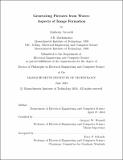Generating Pictures from Waves: Aspects of Image Formation
Author(s)
Accardi, Anthony
Downloadaccardi-phd-eecs-2010.pdf (2.091Mb)
Metadata
Show full item recordAbstract
The research communities, technologies, and tools for image formation are diverse.
On the one hand, computer vision and graphics researchers analyze incoherent light
using coarse geometric approximations from optics. On the other hand, array signal
processing and acoustics researchers analyze coherent sound waves using stochastic
estimation theory and diffraction formulas from physics. The ability to inexpensively
fabricate analog circuitry and digital logic for millimeter-wave radar and
ultrasound creates opportunities in comparing diverse perspectives on image formation,
and presents challenges in implementing imaging systems that scale in size. We
present algorithms, architectures, and abstractions for image formation that relate
the different communities, technologies, and tools. We address practical technical
challenges in operating millimeter-wave radar and ultrasound systems in the presence
of phase noise and scattering.
We model a broad class of physical phenomena with isotropic point sources. We
show that the optimal source location estimator for coherent waves reduces to processing
an image produced by a conventional camera, provided the sources are wellseparated
relative to the system resolution, and in the limit of small wavelength and
globally incoherent light. We introduce quasi light fields to generalize the incoherent
image formation process to coherent waves, offering resolution tradeoffs that surpass
the traditional Fourier uncertainty principle by leveraging time-frequency distributions.
We show that the number of sensors in a coherent imaging array defines a stable
operating point relative to the phase noise. We introduce a digital phase tightening
algorithm to reduce phase noise. We present a system identification framework for
multiple-input multiple-output (MIMO) ultrasound imaging that generalizes existing
approaches with time-varying filters. Our theoretical results enable the application
of traditional techniques in incoherent imaging to coherent imaging, and vice versa.
Our practical results suggest a methodology for designing millimeter-wave imaging
systems. Our conclusions reinforce architectural principles governing transmitter and
receiver design, the role of analog and digital circuity, and the tradeoff between data
rate and data precision.
Description
Thesis Supervisor: Gregory W. Wornell
Title: Professor of Electrical Engineering and Computer Science
Date issued
2010-05-07Series/Report no.
Technical Report (Massachusetts Institute of Technology, Research Laboratory of Electronics);731